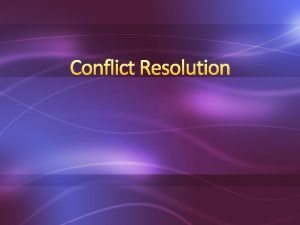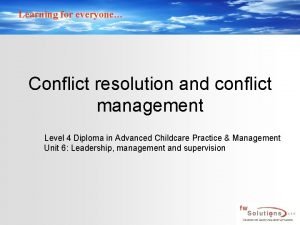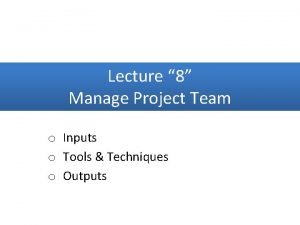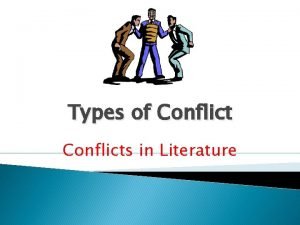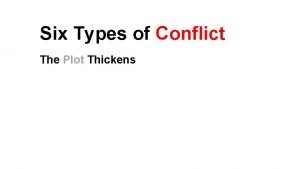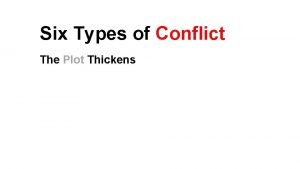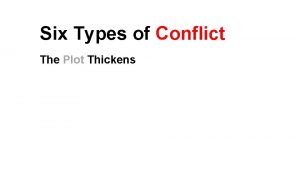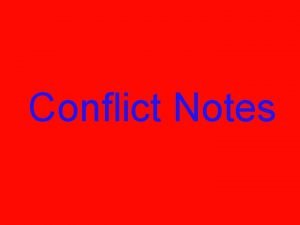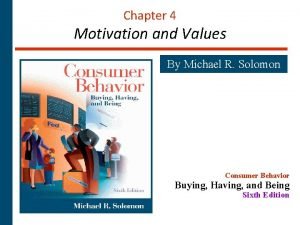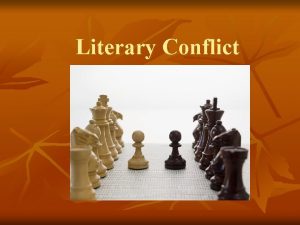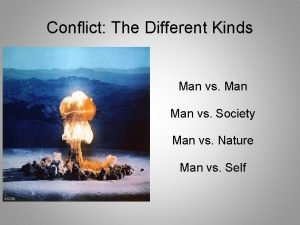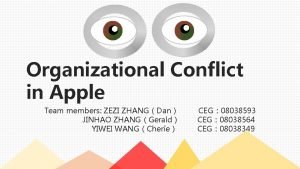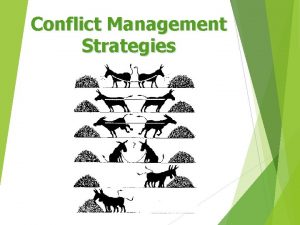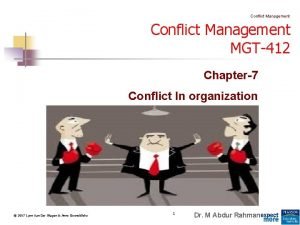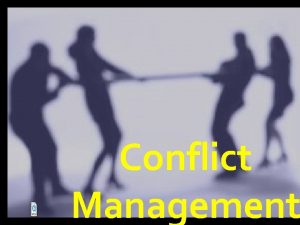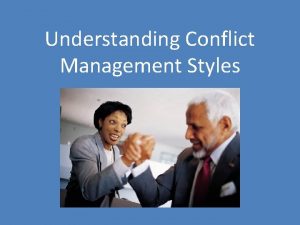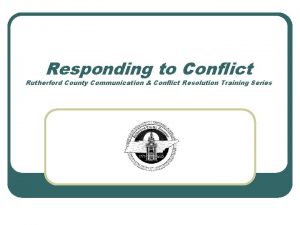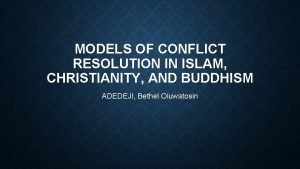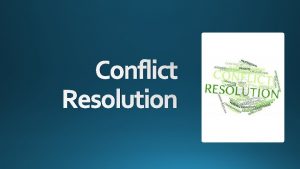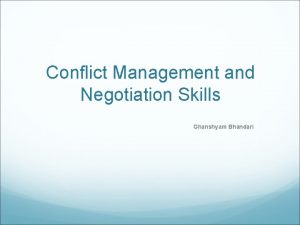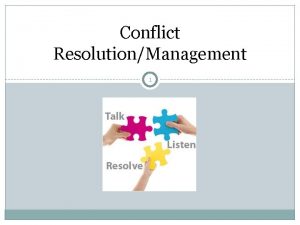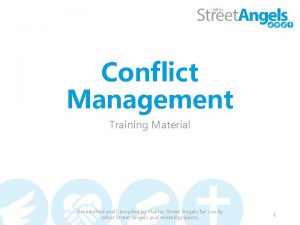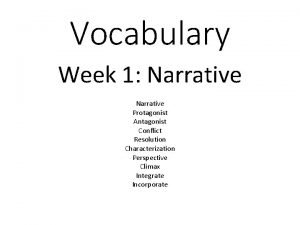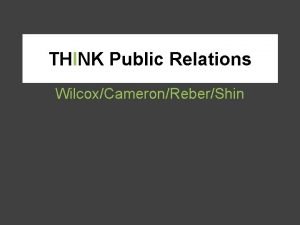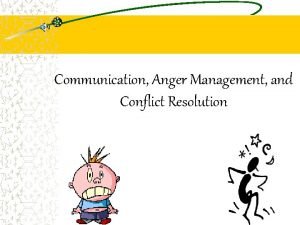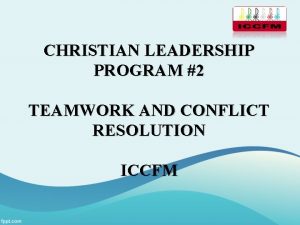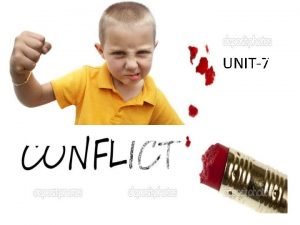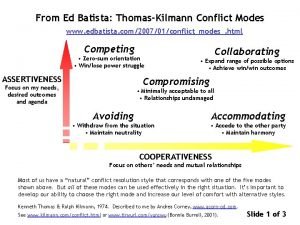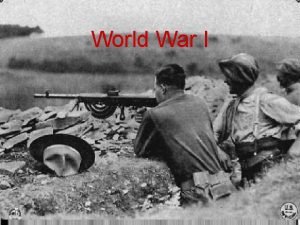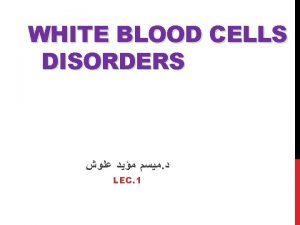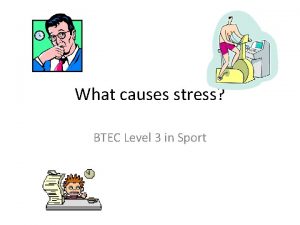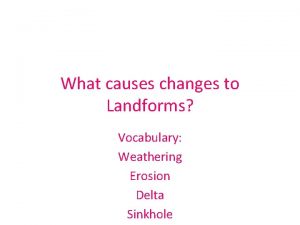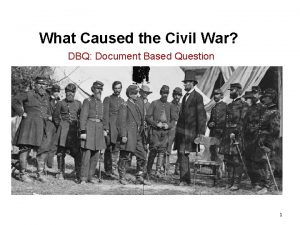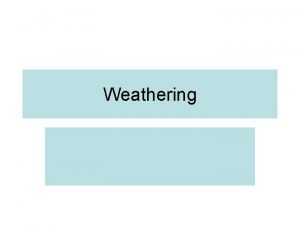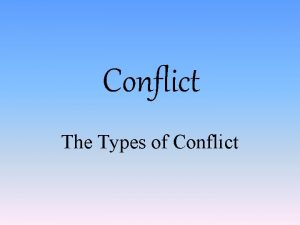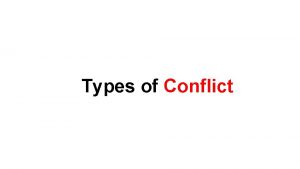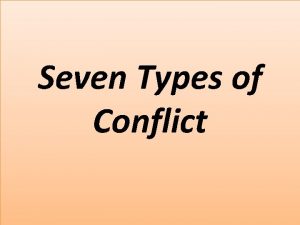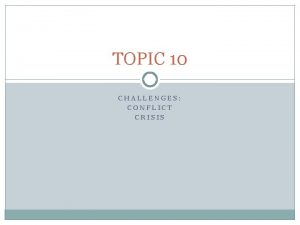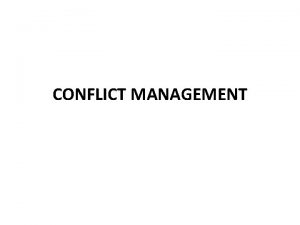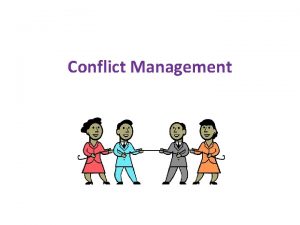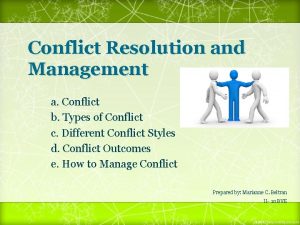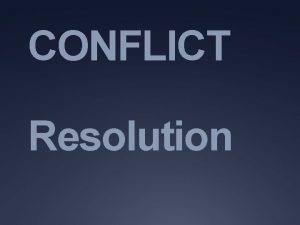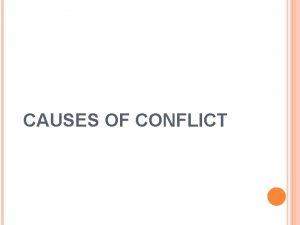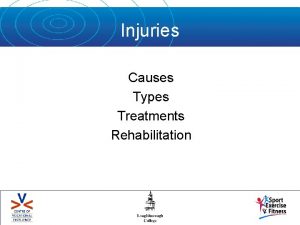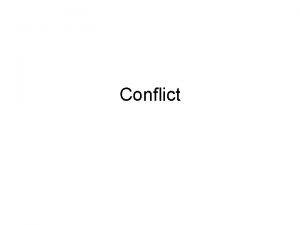HM 02 Conflict Management Conflict causes types management








































































- Slides: 72

HM 02 Conflict Management Conflict, causes, types, management

Content • • • What is a conflict Different views Causes Management Reponses to conflict

Draw a mind map all you know about conflicts!

• V 01 song on conflict. flv

What is a conflict ? “Conflicts is a disagreement between two or more parties”

Conflict exists when individuals who depend on each other express different views, interests, or goals and perceive their views as incompatible or oppositional.

V 02 What is Conflict_. flv

Categories of Conflict • International • National – civil • Socio – economic • Political / religious • Organizational • Family • Personal

V 03 Types of conflict. flv

Different views of the Organizational Conflicts • Traditional – Always harmful • Human relations – inevitable , unavoidable • Modern management – Deficiency in the systems – Positive force for a group to function effectively – Too little and too much is harmful & controlled levels are effective

Conflict • Expressed disagreement—all conflict is expressed verbally or nonverbally. • Conflict can occur only between people who depend on each other. • Conflict involves opposition and is more than just differences. – The perception that our concerns are at odds with those of another – The perception that we and another must reconcile our differences

Principles of Conflict • Conflict is a natural process in all relationships. • Conflict may be overt or covert. – Overt conflict is out in the open and explicit. – Covert conflict is hidden and often unacknowledged. • Passive aggressiveness is aggression that is denied or disguised by the aggressor. • Games are highly patterned interactions in which the real conflicts are hidden or denied.

Principles of Conflict • Conflict may be managed well or poorly. – It can either promote continuing attachment or split a relationship apart, depending on how differences are managed. – It involves intense emotions that we may not know how to handle. – Learning communication conflict skills can help us deal with differences.

Principles of Conflict • Conflict may be good for individuals and relationships. – It allows us to consider other points of views. – It can support our own identity by clarifying how we differ from others. – It expands partners’ views of each other.

Chinese Character for Crisis Danger Opportunity

Causes of Organizational Conflicts • Systems & Personnel • Poor systems – Scarcity of resources • finance, equipment, facilities, – Disagreements • needs, goals, priorities and interests – Poor or inadequate organizational structure – Lack of clarity • in roles and responsibilities – Poor supervision

Causes of Organizational Conflicts • Personal – Difference in : • attitudes, values or perceptions – Poor communication – Lack of teamwork – Over work – Resistance to change – Different approach for common goal

Positives of Conflicts • Enhance room to change • Improve skills to adopt to a situation • Generate energy & activity • Stimulate curiosity & ideas • Eases out tension • Brings out best in people • Leads to clarifications , roles, procedures objectives and forming systems & Policies

Negatives of Conflicts • Brings out instability and chaos • Disrupt the flow of activity • Negatively modifies the organization • Create undue tension unhealthy environment • Tear the organization by piece • Lead to confusion , crisis and disaster

• Write down a conflict that you have experienced in the past

Conflict- the process Ignoring • No talk Contradicting • Bad mouthing Confronting • Undermining • Not cooperating

Signs of Conflicts • Body language • Disagreements, regardless of issue • Withholding bad news • Surprises • Strong public statements • Airing disagreements through media • Conflicts in value system

Signs of Conflicts • Desire for power • Increasing lack of respect • Open disagreement • Lack responsibility on sensitive issues • Lack of clear goals • No discussion of progress, failure relative to goals, failure to evaluate the superintendent fairly, thoroughly or at all.

Responses to Conflict

Responses to Conflict • The exit response involves leaving a relationship either by physically walking out or by psychologically withdrawing. • The neglect response occurs when an individual denies or minimizes problems, disagreements, anger, tension. • The loyalty response is staying committed to a relationship despite differences. • The voice response is an active, constructive strategy for dealing with conflict by talking about problems and trying to resolve them.

Responses to Relational Distress Constructive Destructive Active Passive

Social Influences on Conflict Culture • The majority of Mediterranean cultures regard conflict as a normal and valuable part of everyday life. • Many Hispanic cultures perceive conflict as an opportunity to be expressive and dramatic. • In the U. S. the emphasis on individuality makes conflict competitive. • In most Asian countries conflict is condemned and a solution should be found that benefits everyone and creates harmony.

Social Influences on Conflict Gender • Women – Enact loyalty and voice – Are taught to put a priority on a relationship – Use talk to create and sustain closeness – Tend to defer and compromise • Men – Respond with exit/neglect – Place less emphasis on talk – Minimize problems – May use coercive tactics and force their resolutions – Conflict causes more physical and psychological pain

Social Influences on Conflict Sexual Orientation • Sexual preference doesn’t seem to be a major influence on how individuals see and deal with conflict. – Gays and lesbians appear to have fewer sexual conflicts and to talk more openly about sexual issues than heterosexuals. – Gay and lesbian partners have an intragender empathy that creates less conflict. – Lesbian couples talk the most about relationships, heterosexual couples the next most, and gay couples the least reflecting gender socialization.

Conflict Management Conflict • Stimulation Conflict • Control Conflict • Resolution

A. Conflict stimulation • Main objective is to improve the existing current situation • Methods – Create competition – Import new people / technology – Change establish procedures / position – Communication

B. Conflict Control 1. Expansion of the resource base 2. Relying on rules and procedures 3. Formation of task forces 4. Formation of super ordinate goals 5. Matching personalities

B. Conflict Control…. 6. Share information – by keeping people in the group up-to-date with current issues 7. Express positive expectations about each other 8. Empower each other - publicly crediting colleagues who have performed well and encouraging each other to achieve results 9. Team-building – by promoting good morale and protecting the group's reputation with outsiders 10. Resolve potential conflict – by bringing differences of opinion into the open and facilitating resolution of conflicts

Conflict Resolution

C. Conflict Resolution – process A. Identify the problem/ problems B. Make sure smooth running of the hospital- Smoothening C. Accept deficiencies D. Generate options – Positive – Win- win – Peaceful E. Resolve the conflict

• V 05 resolution Conflict Styles. flv

Approaches to Conflict Win/Lose One party gets satisfaction Lose/Win The other party gets satisfaction Lose/Lose Neither party gets satisfaction Win/Win Both parties feel satisfied

The Relationship You The Other Person Honor yourself, the other, the relationship!

5 ways to manage conflict • • • 39 Avoidance Competition (A) Accommodation (B) Compromise (C) Collaboration (D)

Conflict Continuum • • I win, you lose (competition—A) I lose or give in (accommodate—B) We both get something(compromise—C) We both “win”(collaborate—D) A 40 B C D

1. Competition • Plus – The winner is clear – Winners usually experience gains • Minus – Establishes the battleground for the next conflict – May cause worthy competitors to withdraw or leave the organization 41

2. Accommodation • Plus – Curtails conflict situation – Enhances ego of the other • Minus – Sometimes establishes a precedence – Does not fully engage participants 42

3. Compromise • Plus – Shows good will – Establishes friendship • Minus – No one gets what they want – May feel like a dead end 43

4. Collaboration • Plus – Everyone “wins” – Creates good feelings • Minus – Hard to achieve since no one knows how – Often confusing since players can “win” something they didn’t know they wanted 44

What This Means • Managing conflict means you need to develop several styles and decide which is valuable at any given point of conflict 45

Tips for Managing Workplace Conflict • Build good relationships before conflict occurs • Do not let small problems escalate; deal with them as they arise • Respect differences • Listen to others’ perspectives on the conflict situation • Acknowledge feelings before focussing on facts • Focus on solving problems, not changing people • If you can’t resolve the problem, turn to someone who can help 46 • Remember to adapt your style to the situation and persons involved

V 05 resolution Conflict Styles. flv

Unproductive Conflict Patterns

Unproductive Conflict Patterns • Early stages – The foundation for destructive conflict is established by communication that fails to confirm individuals. – Cross-complaining occurs when one person’s complaint is met by a counter-complaint. – Negative climates tend to build on themselves.

Unproductive Conflict Patterns • Middle stages – Once a negative climate has been set, it is stoked by other unconstructive communication. – Kitchensinking occurs when everything except the kitchen sink is thrown into the argument. • Focusing on specific issues resolves conflicts constructively. – Marked by frequent interruptions that disrupt the flow of talk

Unproductive Conflict Patterns • Later stages – Solutions become the focus • Each person’s proposals are met with counterproposals. – Excessive metacommunication • The communication patterns are discussed and never return to the issues. – Communication that makes up unproductive conflict reflect egocentrism, dogmatism and are self perpetuating. – Unproductive conflict doesn’t involve dual perspective and it seals off awareness of common grounds.

Constructive Communication Unproductive Communication • Validation of each other • Disconfirmation of each other • Sensitive listening • Poor listening • Dual perspective • Preoccupation with self • Recognize other’s • Cross-complaining concerns • Seek clarification • Hostile mind reading

Constructive Communication Unproductive Communication • Infrequent interruptions • Focus on specific issues • Everything is thrown in • Compromises and contracts • Counterproposals • Useful metacommunication • Excessive metacommunication • Summarizing the concerns for both partners • Self-summarizing

Guidelines for Effective Communication During Conflict • Focus on the overall communication system. • Time conflict effectively. – Both people should be psychologically present and not rushed. – Be flexible. – Use bracketing to keep the discussion focused. • Aim for win-win conflict. • Honor yourself, your partner and the relationship. • Show grace when appropriate. – Grant forgiveness or put aside our own needs when there is no standard that says we should.

V 07 Conflict Resolution - Funny Video. flv

Negotiation

Negotiation • Appointed representatives of conflicted groups meet – • in order to resolve their differences with view to reach an agreement. It is a deliberate process – conducted by representatives of groups, designed to reconcile differences and to reach agreements by consensus. • The outcome dependents – on the power relationship between the groups. • Negotiations needs – compromise - one group may win one of their demands and give in on another.

Negotiation • What is negotiation? • Purpose ? • Principles of successful negotiation • Conduction of negotiation

What is Negotiation? • Negotiation is communication with the aim of reaching an agreement • Negotiation is not a surrender • Negotiation describes a process not an outcome

Objectives of Negotiation • To change behavior • End of conflicts, disputes and establish peace and harmony • Positive environment • End to destruction for work processes

Purpose of Negotiation • Prevent or manage violence / conflicts by agreeing to behavior • Improve freedom of communication • Improve relationship with parties & authorities • Resolve disputes with or between parties

Principles of Negotiation 1. Knowing what you have to do ! – Objectives of negotiations – Policies – Instructions 2. Knowing what they want to do ! – Their objectives – Previous statements 3. Knowing their values and culture ! – Improve of your credibility

Key to Success Negotiations • Alert & focused • Use Basic Communication skills • Patience, Patience……. .

Basic communication Skills 1. Use neutral words – So the way you see it…is – ’How would that work…if 2. Paraphrasing – Listening and restating in your own words “So, what you are saying is…, in other words …. .

Basic communication Skills 1. Reframing – Shifting the focus from positions to interests – Encouraging flexibility expressing something in a different way. “In other words, what you want is…” 2. Acceptable Tone – Authoritative – Impartial – Non aggressive

Basic Communication Skills 5. Active Listening – Listening actively even if you do not agree – Be alert and focused – Do not speak to your colleagues when the other person is speaking 6. Communicating openness – Being open to hearing the perceptions and needs of others “How would that work if…”

Basic Communication Skills 7. Non-verbal communication • Eye contact • Paying attention • Nodding • Non-verbal communication is culture specific • Posture • Breathing • Presentation

Conducting Negotiations Stage 1: Introduction (start) Stage 2: Substance (discussion) Stage 3: Conclusion (end)

I. Introduction (The Start) Opening statement and welcome • Follow custom and protocol • Introduction • Agree on Rules • Agree on what you are going to discuss • Possible goal

II. The Discussion – Give equal prominence and time for both parties – Keep them on track – Breaks – Reduce number of options – Agreement – Consider implementation & monitoring

III: Conclusion • Summarize & next steps • Adoption/signing of agreement • Next meeting • Reporting • Immediate report

Thank You ! V 07 Conflict Resolution Funny Video. flv
 Ultimate and proximate causes of behaviour
Ultimate and proximate causes of behaviour Ultimate and proximate causes of behaviour
Ultimate and proximate causes of behaviour Causes of conflict
Causes of conflict Bell and harts eight causes of conflict
Bell and harts eight causes of conflict What causes conflict
What causes conflict What is external conflict
What is external conflict What is conflict and conflict resolution?
What is conflict and conflict resolution? Internal vs external conflict examples
Internal vs external conflict examples Internal/external conflict definition
Internal/external conflict definition 6 types of conflict
6 types of conflict 5 types of conflict
5 types of conflict Six types of conflict
Six types of conflict Conflict of fahrenheit 451
Conflict of fahrenheit 451 Two types of conflict
Two types of conflict Types of motivational conflicts
Types of motivational conflicts Types of conflict styles
Types of conflict styles Literary conflicts
Literary conflicts 4 types of literary conflict
4 types of literary conflict Man vs society meaning
Man vs society meaning The crucible introduction notes
The crucible introduction notes Vertical conflict definition
Vertical conflict definition 7 types of conflict
7 types of conflict Mainwaring strategies for managing conflict
Mainwaring strategies for managing conflict Smooth running
Smooth running Examples of functional conflict
Examples of functional conflict Shark conflict style
Shark conflict style Conflict management exercise
Conflict management exercise Structual conflict
Structual conflict Fox conflict style
Fox conflict style Conflict management conclusion
Conflict management conclusion 6 steps of conflict resolution
6 steps of conflict resolution Salam model of conflict management
Salam model of conflict management Police conflict management
Police conflict management Watch mastering conflict management and resolution at work
Watch mastering conflict management and resolution at work Concept of conflict
Concept of conflict Maybo safer model
Maybo safer model Watch mastering conflict management and resolution at work
Watch mastering conflict management and resolution at work Conflict management training materials
Conflict management training materials Conflict management - vocabulary
Conflict management - vocabulary Think public relations
Think public relations Resident customer service
Resident customer service Conflict norming exercise
Conflict norming exercise Anger management and conflict resolution
Anger management and conflict resolution Christian leadership and conflict management
Christian leadership and conflict management What is conflct
What is conflct Conflict management and negotiation skills
Conflict management and negotiation skills Conflict style
Conflict style Anger management and conflict resolution
Anger management and conflict resolution Top management middle management first line management
Top management middle management first line management Top management middle management first line management
Top management middle management first line management Top management and middle management
Top management and middle management Cause of colonialism
Cause of colonialism Main ww1
Main ww1 Cause of world war 1
Cause of world war 1 Wwi gas warfare
Wwi gas warfare What causes winds
What causes winds Horse latitude
Horse latitude What creates wind
What creates wind What makes wind blow
What makes wind blow How are deserts formed
How are deserts formed Why do we have seasons
Why do we have seasons Admiral nagumo
Admiral nagumo ميسم مؤيد
ميسم مؤيد What is economics
What is economics Why are there tides
Why are there tides Natural causes of landslide
Natural causes of landslide What causes weathering
What causes weathering What caused the civil war dbq
What caused the civil war dbq Symptoms of metal fume fever
Symptoms of metal fume fever Heaving apex beat causes
Heaving apex beat causes Dissolve
Dissolve Wearing down with water
Wearing down with water How does gravity affect weathering
How does gravity affect weathering


